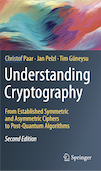This is the second edition of Understanding Cryptography. Ever since we released the first edition in 2009, we have been humbled by the many positive responses we received from readers from all over the world. Our goal has always been to make the fascinating but also challenging topic of cryptography accessible and fun to learn. Key concepts of the book are that we focus on cryptography with high practical relevance, and that the necessary mathematical material is accessible for readers with a minimum background in college-level calculus. The fact that Understanding Cryptography has been adopted as textbook by hundreds of universities on all continents (that is, if we ignore Antarctica) and the feedback we received from individual readers and instructors makes us believe that this approach is working.
Understanding and employing cryptography has become a central requirement for securing virtually any digital application, whether user app, cloud service, or even medical implant.
Heavily revised and updated, the long-awaited second edition of Understanding Cryptography follows the unique approach of making modern cryptography accessible to a broad audience, requiring only a minimum of prior knowledge. After introducing basic cryptography concepts, this seminal textbook covers nearly all symmetric, asymmetric, and post-quantum cryptographic algorithms currently in use in applications—ranging from cloud computing and smart phones all the way to industrial systems, block chains, and cryptocurrencies.a
Topics and features:
- Helps develop a comprehensive understanding of modern applied cryptography
- Provides a thorough introduction to post-quantum cryptography consisting of the three standardized cipher families
- Includes for every chapter a comprehensive problem set, extensive examples, and a further-reading discussion
- Communicates, using a unique pedagogical approach, the essentials about foundations and use in practice, while keeping mathematics to a minimum
- Supplies up-to-date security parameters for all cryptographic algorithms
- Incorporates chapter reviews and discussion on such topics as historical and societal context
This must-have book is indispensable as a textbook for graduate and advanced undergraduate courses, as well as for self-study by designers and engineers.
The authors have more than 20 years’ experience teaching cryptography at various universities in the US and Europe. In addition to being renowned scientists, they have extensive experience with applying cryptography in industry, from which they have drawn important lessons for their teaching.
Table of Content
Chapters of the Book
Chapter 1: Introduction to Cryptography and Data Security
Chapter 2: Streamciphers
Chapter 3: The Data Encryption Standard (DES) and Alternatives
Chapter 4: The Advanced Encryption Standard (AES)
Chapter 5: More about Block Ciphers
Chapter 6: Introduction to Public-Key Cryptography
Chapter 7: The RSA Cryptosystem
Chapter 8: Public-Key Cryptosystems Based on the Discrete Logarithm Problem
Chapter 9: Elliptic Curve Cryptosystems
Chapter 10: Digital Signatures
Chapter 11: Hash Functions
Chapter 12: Post-Quantum Cryptography
Chapter 13: Message Authentication Codes (MACs)
Chapter 14: Key Establishment
How to Use the Book
Classroom Use
The material in this book has evolved over many years and is “classroom proven”. We’ve taught it both as a course for advanced undergraduate students and graduate students in computer science/math/electrical engineering, as well as a first-year undergraduate course for students majoring in our IT security program. We found that one can teach most concepts introduced in the book in a two-semester course, with 90 minutes of lecture time plus 90 minutes of help sessions with exercises per week (total of 10 ECTS credits). In a typical US-style three-credit course, or in a one-semester European course, some of the material should be omitted. Here are some reasonable choices for a one-semester course:
Course Curriculum 1
Focus on the application of cryptography, e.g., in an applied course in computer science or a basic course for subsequent security classes, e.g., in a cybersecurity program. A possible curriculum is:
Chap. 1; Sects. 2.1-2.2; Chap. 4; Sect. 5.1; Chap. 6; Sects. 7.1-7.3; Sects. 8.1-8.3; Sects. 10.1-10.2; Sects. 11.1-11.3; Sects. 12.1 & 12.4; Sect. 13.1; Sects. 14.1 -14.3.
Course Curriculum 2
Focus on cryptographic algorithms and their mathematical background, e.g., as a theory course in computer science or a crypto course in a math program. This curriculum also works nicely as preparation for a more theoretical course in cryptography:
Chap. 1; Chap. 2; Chap. 4; Chap. 6; Chap. 7; Sects. 8.1 –
8.4; Chap. 9; Sects. 10.1–10.2; Sects. 11.1–11.3; Sects. 12.1, 12.2 & 12.4.
Solution Manual
For all odd numbered problems, we provide a manual.
For instructors, a manual with solutions to all problems can be ordered free of charge from the authors.

Errata List
No one is perfect. You can download the errata list of the second edition below. It will be updated frequently.
